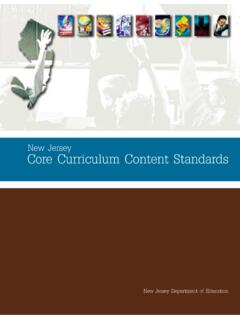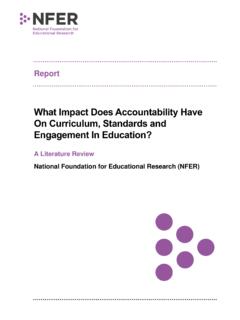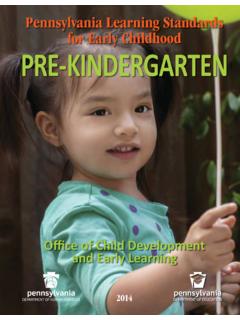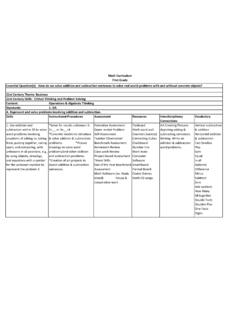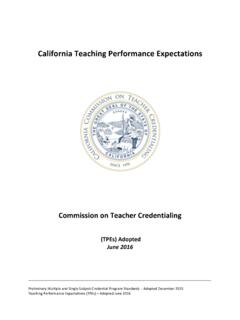Transcription of Aligning Curriculum, Instruction, and Assessment
1 2012 Measurement Inc 1 Aligning curriculum , Instruction, and Assessment Michael B. Bunch, Measurement Incorporated A key component of educational achievement test validation is alignment of the test to both curriculum and instruction. By alignment , we mean the degree to which the items of the test, both individually and collectively, match the structure and intent of the curriculum and instruction. This paper has several purposes: 1. To provide an overview of the goal and process of alignment 2. To raise some important questions we need to answer as we create tests to assess college and career readiness, and 3. To expand our view of alignment of tests of college and career readiness Goal and Process The goal of alignment is to make curriculum , instruction, and Assessment work toward the same ends. Generally, we start with curriculum , lay out goals for instruction, instruct to achieve those goals, and assess to determine how successful we ve been in achieving the goals set forth in the curriculum .
2 We tend to think of the process in terms of a triangle, as shown in Figure 1. Figure 1: The alignment Triangle The three components of Figure 1 are interactive; any of the three can and should inform the other two. For example, in addition to curriculum driving instruction and Assessment , it is also possible that instruction can provide feedback for improving curriculum and refining the format of test items. Similarly, Assessment can identify weaknesses in instruction that can be corrected and detect holes in curriculum that can be filled. Alignin curriculum , Assessment , and Instruction 2012 Measurement Inc 2 Clarifying Terms For the purposes of this paper, I confine my remarks to summative Assessment and offer the following working definitions. curriculum : The written set of educational outcomes and associated content that students are to learn. This will include the knowledge, skills, and abilities we expect students to acquire or master after a period of appropriate instruction.
3 curriculum may include prescribed activities and procedures designed to bring about mastery of that content. Instruction: What actually happens at the classroom level (and at home and in the community)? This includes all the activities of teachers, students, aides, parents, and others involved in transmitting to students a set of knowledge, skills, and abilities. For formal evaluation purposes, however, only those activities under the control of educational authorities will be considered. Assessment : The formal process of gathering, analyzing, and reporting standardized information about the acquisition of knowledge, skills, and abilities for a group of students. For the purposes of this paper, we will focus on summative Assessment ( , formal Assessment at the end of a prescribed period of instruction, such as a semester or school year). The Process alignment as a formal process with quantifiable outcomes is fairly new. For decades, test developers prepared blueprints and specifications, wrote items, assembled tests, and simply compared the final versions to the original blueprints.
4 Quantification was typically limited to comparing percentages of items in cells of a final test blueprint with those of an ideal form. At the item level, test developers submitted items to committees of reviewers to make sure each item conformed not only to the content of the curriculum but to the format and process of the instruction as well. In the past decade, Andy Porter and Norman Webb have contributed significantly to the quantification of the alignment process. Andy Porter introduced the Survey of Enacted curriculum (SEC, ). Norman Webb has given us the Webb alignment Tool (WAT, ). Both employ Webb s depth of knowledge (DOK, ) scale. With these tools, educators are able to plot curriculum , instruction, and Assessment on a two-dimensional grid to create a variety of useful visual displays. Particularly useful is the side-by-side comparison of a map for a curriculum and its associated test. The peaks and valleys of one map should match those of the other. To the extent that they do, the test is aligned to the curriculum .
5 Similarly, the map of a local curriculum or even a segment of instruction can be compared to a state curriculum map. Alignin curriculum , Assessment , and Instruction 2012 Measurement Inc 3 The mapping procedure for both the Porter and Webb approaches involves groups of educators evaluating and indexing large amounts of material. As with any procedure that involves human judges, the final product typically represents general consensus rather than perfect agreement. Fortunately, the intra-group differences are generally small enough that the final product is quite a valid and reliable statement about the curriculum , instruction, or Assessment . Some Important Questions Since the Partnership for Assessment of Readiness for College and Careers (PARCC) and the Smarter Balanced Assessment Consortium (SBAC) began developing plans for the assessments of 2014 15, the alignment conversation has focused on the tests and the Common Core State Standards (CCSS). So far, we haven t heard much about instruction, other than that it is assumed that states, districts, and schools will implement these standards.
6 It is an assumption that bears testing. Are the CCSS being implemented, and if so, how? In a recent white paper, Cut Scores for 21st Century Assessment , I mentioned that states are implementing the Common Core State Standards in different ways and on different schedules. If we develop tests well aligned to the CCSS but fail to provide instruction equally well aligned, the results of the tests become meaningless because the triangle is missing one of its points. Are the ideals of the test designers reflected in instruction? Both PARCC and SBAC assessments are based on an evidence-centered design. Moreover, both consortium Assessment -development plans assume instruction based on cognitive research. Indeed, such an assumption is well warranted, as the No Child Left Behind bill refers to scientifically based research over 100 times. But is this assumption warranted in terms of what teachers are actually teaching? Has anyone told them that their students will be assessed in this manner and that they should be teaching in a way that reflects best practice as defined by cognitive research?
7 At this point, it is too late to expect teacher-training institutions to assume this responsibility. It is up to states and districts to make sure teachers and ultimately students are ready. Will they be? How will test design be informed by current instruction? Both consortia have built into their development schedules reviews of items by in-service educators. That is commendable. The important question now is, How will we incorporate the experiences of those educators into the refinement of the items and tests? This question has implications not only for how we record and utilize their ratings of items but how we design the rating forms, conduct the training, and manage the review meetings. The following exchange is synthesized from several item-review meetings we have conducted over the past 30 years. It illustrates what can and does happen at these meetings: Will students have an opportunity to learn? Alignin curriculum , Assessment , and Instruction 2012 Measurement Inc 4 Chair: So we are calling item 12 DNU (Do Not Use).
8 And our reason? Teacher 1: Does not align. Chair: OK, does not align. And the comment we will put beside that entry? Teacher 2: We don t actually teach this in fifth grade. It s more a sixth grade objective. Chair: Can we say that? It s on the state curriculum for fifth grade. Teacher 3: Yes, that s true. A friend of mine was on the committee that prepared the standards, and she tried to get them to move it, but they wouldn t listen. Teacher 2: And besides, the format is different from the way we teach it. Chair: So we mark item 12 DNU and note that it is incorrectly formatted and off-grade. All: Yes, that sounds good. No doubt, the review sessions for PARCC and SBAC will not go quite like this, but it is important to begin thinking now about the training, forms, and recording procedures of the review sessions in order to make sure the tests that emerge from those sessions are aligned to the curriculum and instruction or that any misalignment between curriculum and instruction can be corrected before the spring of 2015.
9 Will students have an opportunity to learn? The United States Court of Appeals (Fifth Circuit) ruled on May 4, 1981, that The State may not deprive its high school seniors of the economic and educational benefits of a high school diploma until it has demonstrated that the SSATII (the Florida minimum competency test) is a fair test of that which is taught in its classrooms. (Debra P. v. Turlington 474 F. Supp. 244 ( Fla., 1981)). Even though the PARCC and SBAC tests may not carry diploma sanctions, the court s decision set clear ground rules for test development when postsecondary opportunities are at stake: Alignin curriculum , Assessment , and Instruction 2012 Measurement Inc 5 1. Students must be told the specific objectives on the test. 2. Students must be given instruction in these objectives. 3. This instruction must be rational, orderly, and cumulative. 4. Students must be given time to master these objectives. 5. Instruction must include accountability. 6.
10 Students must be afforded opportunity for remedial instruction. The Debra P. decision resulted in a two-year delay in the implementation of the tests, during which time Florida was required to conduct a series of surveys to satisfy the court that students had indeed had an opportunity to learn. As the CCSS are rolled out, who is monitoring their implementation at the classroom level? Who will be able to state unequivocally that all students have had an opportunity to learn the assessed content by the spring of 2015? We have a lot to think about in the next couple of years: Evidence-centered design, instruction based on scientific research, making sure everyone gets a chance to learn all this stuff, and making sure we test what was taught. Could our plates possibly get any fuller? Yes. Expanding Our View And now for something completely To this point we have viewed alignment in two-dimensional space ( , a triangle whose three points are curriculum , instruction, and Assessment ).


